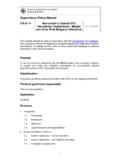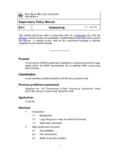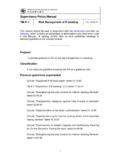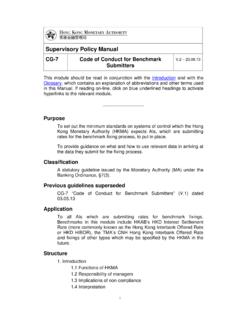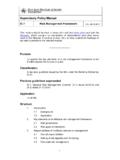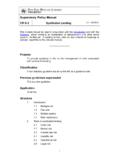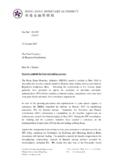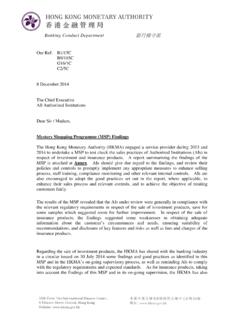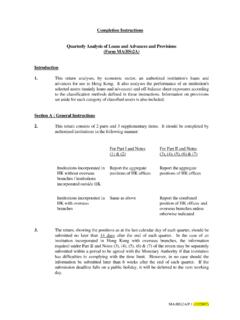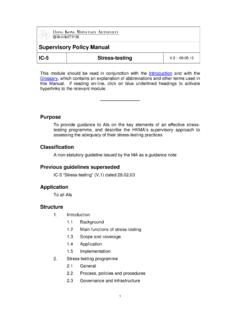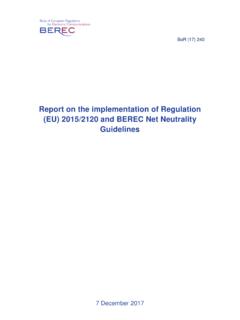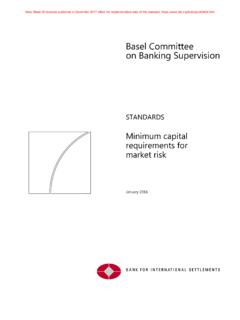Transcription of Our Ref: B1/15C B9/195C Dear Sir / Madam, - hkma.gov.hk
1 Our Ref: B1/15C B9/195C 19 December 2018 The Chief Executive All Authorized Institutions Dear Sir / Madam, supervision for Bank Culture I am writing to announce the Hong Kong Monetary Authority s (HKMA) supervisory measures for bank culture, following consultation with the industry. The HKMA initiated a Bank Culture Reform last year through promoting the adoption of a holistic and effective framework for fostering a sound culture within authorized institutions (AIs), with particular attention given to three pillars, namely governance, incentive systems, and assessment and feedback mechanism. Practical guidance on these three pillars was also provided to all AIs through the circular of 2 March 2017. With a view to gauging the progress of Bank Culture Reform in Hong Kong and providing further guidance to the industry where necessary, the HKMA will implement the following supervisory measures: (i) Requiring AIs to conduct self-assessment: AIs will be required to review and report their governance arrangements as well as policies and procedures in relation to corporate culture and the implementation of the enhancement measures in fostering a sound bank culture with respect to the circular last year.
2 For the avoidance of doubt, the self-assessment is intended to be an opportunity for AIs to reflect on any insights, lessons learnt and issues encountered in the implementation of enhancement measures, but not a check-box type compliance exercise; - 2 - (ii) Conducting focus reviews: The HKMA will, through site visits and/or off-site reviews, assess and benchmark AIs practices with respect to key areas of bank culture; and (iii) Undertaking culture dialogues: The HKMA will meet with senior management and/or board members of AIs responsible for bank culture to gather insights and lessons learnt. Furthermore, promoting good banking culture is a common aspiration of jurisdictions around the world. In pursuing the culture initiative, the HKMA aims to draw on the valuable and relevant experience from overseas practices.
3 It is important to keep an eye on any major conduct incidents occurred globally and consider the relevance of the findings in the context of Hong Kong as there are bound to be lessons that we can all learn. In this connection, we expect AIs, when conducting self-assessment, to also make reference to the findings of major conduct or other serious misbehaviour incidents outside Hong Kong as they review and assess whether there are any potential similar issues that may apply to the AI, benchmark their culture and behavioural standards against community standards and expectations, and report the findings to the boards as appropriate. Recent examples include the Royal Commission into Misconduct in the Banking, Superannuation and Financial Services Industry in Australia1 and the Prudential Inquiry into the Commonwealth Bank of Australia by the Australian Prudential Regulation Authority2.
4 We will gather from AIs insights, lessons learnt and issues encountered through the above supervisory measures and monitor the development of bank culture, while exploring other supervisory measures taking into account overseas experience. The HKMA would first commence the self-assessment exercise. In terms of implementation timeline, the HKMA considers it appropriate to implement the self-assessment by phases. The first phase will cover about 30 AIs including all major retail banks and selected foreign bank branches with substantial operations in Hong Kong. The HKMA will inform these AIs individually. AIs covered in the first phase will be expected to complete the self-assessment and submit to the HKMA within six months. For the remaining AIs which are not covered in the first phase, these AIs are still expected to reflect on their own insights, lessons learnt and issues encountered in their culture enhancement initiatives.
5 1 Royal Commission into Misconduct in the Banking, Superannuation and Financial Services Industry in Australia (Interim Report issued on 28 September 2018) 2 Prudential Inquiry into the Commonwealth Bank of Australia by the Australian Prudential Regulation Authority (Final Report released on 1 May 2018) - 3 - We have designed a template to assist AIs in conducting the self-assessment. The template, which is enclosed at the Annex, is divided into two parts. The first part Culture Questions to the Board comprises a set of high-level questions, aiming to serve as an opportunity for the AIs board to reflect on any insights, lessons learnt and issues encountered in the implementation of enhancement measures. The second part consists of specific questions for AIs to review and report their governance arrangements as well as policies and procedures in relation to corporate culture and the implementation of the enhancement measures in fostering a sound bank culture with respect to the circular last year.
6 As for focus reviews and culture dialogues, the HKMA will inform AIs of the details individually. Should you have any questions about this circular, you may contact Ms Christine Wong at 2878 8288 or Mr Danny Yip at 2878 1304. Yours faithfully, Arthur Yuen Deputy Chief Executive Encl. 1 Annex Self-assessment on Bank Culture Reform Part A: Culture Questions to the Board Completion Instructions: This part of the self-assessment should be completed under the guidance of the board of your institution, preferably having discussed in and incorporated inputs from the dedicated board-level committee in advising and assisting the board in discharging its responsibilities for your institution s culture-related matters, and should be co-signed by the chair (an independent non-executive director) of the dedicated board-level committee responsible for culture-related matters and the Chief Executive of your institution.
7 For the avoidance of doubt, this self-assessment is intended to be an opportunity for institutions to reflect on any insights, lessons learnt and issues encountered in the implementation of enhancement measures, but not a check-box type compliance exercise. Questions: 1. How does your board see its role in relation to establishing your institution s culture and behavioural standards that promote prudent risk-taking and fair treatment of customers? 2. What proactive steps did your board (including relevant board-level committee(s)) take in driving your institution s culture enhancements? 3. Regarding the progress of culture reform at your institution, what have you learnt from fostering a sound culture within your institution, including the (i) good practices and (ii) key areas for improvement at your institution?
8 Which pillars (governance, incentive systems, assessment and feedback mechanisms) or other areas do they relate to? 4. In your view, what are the most salient indicators (quantitative and/or qualitative) that you would use to measure and assess your institution s culture? 5. Based on the indicators mentioned above, what tangible outcomes have you seen from fostering a sound culture within your institution? 6. Looking forward, what are your institution s priorities on culture reform over the coming twelve months (i) in relation to the three pillars, and (ii) among the business units in your institution (or other categorization that you see appropriate), and which do you expect to be the most difficult to achieve? 7. Looking forward, how does your institution encourage/motivate your staff at all levels to adopt and adhere to your institution s desired culture and behavioural standards?
9 8. If your institution is a part of an overseas-incorporated institution, how does your cultural programme interface with that of your head office and what adjustments have been/will be made having regard to local circumstances1? 9. Is there any additional contextual information which you feel is relevant in understanding the progress of culture reform at your institution? 1 If there are any review or audit reports on culture initiated by the head office that may be relevant to the context of this self-assessment, they may be attached as part of your submission as appropriate. 2 Part B(1): Detailed self-assessment Completion Instructions: This part of the self-assessment should be carried out by the internal audit department, the compliance department or other equivalent unit of your institution. It should be signed by the head of the relevant department and should be approved and co-signed by the Chief Executive of your institution.
10 Your institution may wish to provide supporting documents to illustrate your institution s work under the respective items below as appropriate. Questions: Question No. Question Response Yes/No If yes, please elaborate with examples/evidence, including the relevant timing (if any). If no, please explain2. Section A: Governance 1 Does the board of your institution play a leading role in establishing your institution s culture and behavioural standards that promote prudent risk-taking and fair treatment of customers? Yes/No 2 Does your institution have any effective mechanisms in place for ensuring that your institution s desired culture is understood and shared by all levels of staff? Yes/No (What are the mechanisms?) 3 Does your institution have a dedicated board-level committee to advise and assist the board of your institution in discharging its responsibilities for your institution s culture-related matters, or in the process of establishing one?
